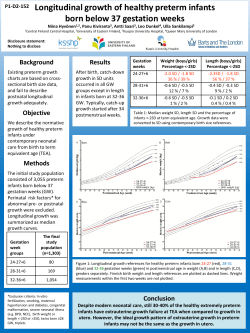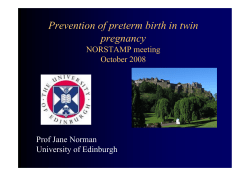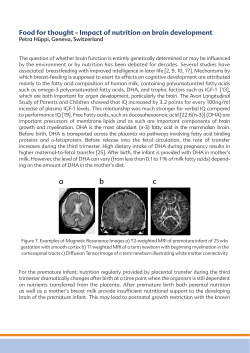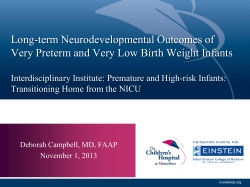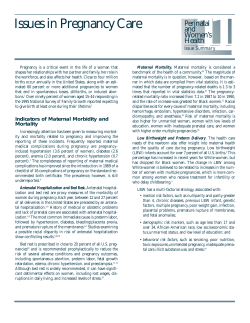
ABC SERIES
ABC SERIES Features of the ABC Series Cardiotocography and fetal biophysical profiling are two tools often used to determine the physiological status of the potentially compromised fetus. Unfortunately these tools have no benefit in predicting and preventing poor outcomes in high risk pregnancies. Some evidence shows, however, that computerised cardiotocography is more accurate in predicting poor outcome than subjective clinical assessment alone. The biophysical profile takes into account the tone, movement, breathing, heart rate pattern of the fetus, and liquor volume. The ABC titles are serialised and peer reviewed in the BMJ before being published in this great series of books The pages are always laid out in two columns with the highly illustrated ‘slide show’ of relevant visual aids alongside the text, pulling out key points from the text • Each book is easy to read and contains a consistent style and the following key features which help to show the important aspects of the text ABC of preterm birth Comparison tables Graphs and charts Advertisements and other cultural references Over the past 20-30 years the incidence of preterm birth in most developed countries has been about 5-7% of live births. The incidence in the United States is higher, at about 12%. Some evidence shows that this incidence has increased slightly in the past few years, but the rate of birth before 32 weeks' gestation is almost unchanged, at 1-2%. Several factors have contributed to the overall rise in the incidence of preterm birth. These factors include increasing rates of multiple births, greater use of assisted reproduction techniques, and more obstetric intervention. Part of the apparent rise in the incidence of preterm birth, however, may reflect changes in clinical practice. Increasingly, ultrasonography rather than the last menstrual period date is used to estimate gestational age. The rise in incidence may also be caused by inconsistent classification of fetal loss, still birth, and early neonatal death. In some countries, infants who are born after very short gestations (less than 24 weeks) are more likely to be categorised as live births. With the limited provision of antenatal or perinatal care in developing countries, there are difficulties with population based data. Registration of births is incomplete and information is lacking on gestational age, especially outside hospital settings. Data that are collected tend to give only estimates of perinatal outcomes that are specific to birth weight. These data show that the incidence of low birth weight is much higher in developing countries than in developed countries with good care services. In developing counties, low birth weight is probably caused by intrauterine growth restriction. Maternal undernutrition and chronic infection in pregnancy are the main factors that cause intrauterine growth restriction. Although the technical advances in the care of preterm infants have improved outcomes in developed countries with well resourced care services, they have not influenced neonatal morbidity and mortality in countries that lack basic midwifery and obstetric care. In these developing countries, the priorities are to reduce infection associated with delivery, identify and manage pregnancies of women who are at risk, and provide basic neonatal resuscitation. 7 Preterm birth rate (%) Incidence The rate of preterm birth varies between ethnic groups. In the United Kingdom, and even more markedly in the United States, the incidence of preterm birth in black women is higher than that in white women of similar age. The reason for this variation is unclear because differences remain after taking into account socioeconomic risk factors. 6 5 Total 29-32 weeks 33-36 weeks <28 weeks 4 3 2 1 0 1980 1985 1990 1995 1999 Year of birth Rates of preterm birth, by gestational age, in singleton live births in New Zealand, 1980-99 Percentage of preterm births in United States* Gestational age Year 1981 1990 2000 <37 weeks 9.4 10.6 11.6 <32 weeks 1.81 1.92 1.93 *Adapted from MacDorman MF et al. Pediatrics 2002;110: 1037-52 Risk factors for babies with low birth weight in developing countries x x x x x Infection, especially malaria Poor maternal nutrition Maternal anaemia Low maternal body mass index before pregnancy Short interval between pregnancies Antepartum haemorrhage Cervical incompetence/ uterine malformation Spontaneous preterm labour Intrauterine growth restriction Pregnancy associated hypertension Causes of preterm birth 2 Preterm prelabour rupture of membranes Multiple pregnancy Causes of preterm birth Smoking cessation programmes can lower the incidence of preterm birth Maternal and fetal complications About 15% to 25% of preterm infants are delivered because of maternal or fetal complications of pregnancy. The principal causes are hypertensive disorders of pregnancy and severe intrauterine growth restriction, which is often associated with hypertensive disorders. The decision to deliver these infants is informed by balancing the risks of preterm birth for the infant against the consequence of continued pregnancy for the mother and fetus. Over the past two decades improved antenatal and perinatal care has increased the rate of iatrogenic preterm delivery. During that time the incidence of still birth in the third trimester has fallen. Diagnostic images *Adapted from MacDorman MF et al. Pediatrics 2002;110:1037-52 Mode of delivery Vaginal delivery of the preterm infant is associated with lower maternal morbidity than delivery by caesarean section. It is important, however, to consider the following points: x Obstetric history x Likely interval between induction and delivery in the context of deterioration of maternal health x Probability of achieving a vaginal delivery versus risk of emergency caesarean section x Presentation and prelabour condition of the fetus. Breech delivery In developed countries with good antenatal services most term breech pregnancies are managed by elective caesarean section, as are many multiple pregnancies. The increase in caesarean sections has caused a loss of obstetric skill in vaginal delivery of breech and multiple pregnancies. Most planned preterm breech and twin pregnancies are delivered by elective caesarean section even though there is no clear evidence of benefit. Tinted key Doppler measurement of middle cerebral arterial flow. Abnormal waveforms can show cardiovascular adaptations to placental insufficiency Induction of labour is most likely to be successful in a woman with a favourable cervix (as assessed by the Bishop score) who has had no caesarean sections and has a history of vaginal delivery information boxes 10 Twin pregnancy increases the risk of preterm birth 1.0 1988-90 0.8 1993-94 0.6 Bulleted lists 1998-99 0.4 0.2 0 22 Outcomes after preterm birth Broadly, outcomes improve with increasing gestational age, although for any given length of gestation survival varies with birth weight. Other factors, including ethnicity and gender also influence survival and the risk of neurological impairment. The outcomes for preterm infants born at or after 32 weeks of gestation are similar to those for term infants. Most serious problems associated with preterm birth occur in the 1% to 2% of infants who are born before 32 completed weeks' gestation, and particularly the 0.4% of infants born before 28 weeks' gestation. Modern perinatal care and specific interventions, such as prophylactic antenatal steroids and exogenous surfactants, have contributed to some improved outcomes for very preterm infants. The overall prognosis remains poor, however, particularly for infants who are born before 26 weeks' gestation. The outcome for preterm infants of multiple pregnancies can be better than that of singleton pregnancies of the same gestation. In term infants the situation is reversed. The Doppler measurement of umbilical arterial flow is used to test fetal wellbeing. This recording shows reversed end diastolic velocity waveform 23 24 25 26 27 28 29 30 31 32 Gestation (weeks) Mortality in UK neonatal intensive care cohorts of infants born before 32 weeks’ gestation. Adapted from Parry G, et al. Lancet 2003;361:1789-91 Photographs and line drawings Outcomes for infants live born before 26 weeks’ gestation in British Isles* Gestation (weeks) 22 23 24 25 Survival to discharge (%) 1 11 26 44 Survival without handicap at 30 months (%) 0.7 5 12 23 *Adapted from Wood NS et al. New Engl J Med 2000;343:378-84 3 ± Spontaneous preterm labour and rupture of membranes Most preterm births follow spontaneous, unexplained preterm labour, or spontaneous preterm prelabour rupture of the amniotic membranes. The most important factors that contribute to spontaneous preterm delivery are a history of preterm birth and poor socioeconomic background of the mother. Interaction of the many factors that contribute to the association of preterm birth with socioeconomic status is complex. Mothers who smoke cigarettes are twice as likely as non-smoking mothers to deliver before 32 weeks of gestation, although this effect does not explain all the risk associated with social disadvantage. Evidence from meta-analysis of randomised controlled trials shows that antenatal smoking cessation programmes can lower the incidence of preterm birth. Women from poorer socioeconomic backgrounds, however, are least likely to stop smoking in pregnancy although they are most at risk of preterm delivery. No studies have shown that other interventions, such as better antenatal care, dietary advice, or increased social support during pregnancy, improve perinatal outcomes or reduce the social inequalities in the incidence of preterm delivery. Multiple pregnancy and assisted reproduction Multifetal pregnancy increases the risk of preterm delivery. About one quarter of preterm births occur in multiple pregnancies. Half of all twins and most triplets are born preterm. Multiple pregnancy is more likely than singleton pregnancy to be associated with spontaneous preterm labour and with preterm obstetric interventions, such as induction of labour or delivery by caesarean section. The incidence of multiple pregnancies in developed countries has increased over the past 20-30 years. This rise is mainly because of the increased use of assisted reproduction techniques, such as drugs that induce ovulation and in vitro fertilisation. For example, the birth rate of twins in the United States has increased by 55% since 1980. The rate of higher order multiple births increased fourfold between 1980 and 1998, although this rate has decreased slightly over the past five years. In some countries two embryos only are allowed to be placed in the uterus after in vitro fertilisation to limit the incidence of higher order pregnancy. Singleton pregnancies that follow assisted reproduction are at a considerable increased risk of preterm delivery, probably because of factors such as cervical trauma, the higher incidence of uterine problems, and possibly because of the increased risk of infection. Preventing pre-eclampsia Women who have had pre-eclampsia can be given low doses of aspirin in a future pregnancy. In a systematic review of Epidemiology ofover preterm randomised trials that involved 30 000birth women, prophylactic antiplatelet treatment that was started in the first trimester reduced the risk of recurrent pre-eclampsia and andgroup neonatal death by about 15%. Preterm birthsstillbirth by ethnic in United Calcium supplements in the diet can reduce the risk of States 2000* hypertension and pre-eclampsia associated with pregnancy for x Black—17.3% women at high risk, and in communities with a low intake of x Hispanic—11.2% calcium. x Non-Hispanicdietary white—10.4% Monitoring the fetal heart rate can help determine the physiological wellbeing of the fetus. This cardiotocogram shows fetal tachycardia with reduced variability and decelerations Please scroll down to see a sample chapter ± • Doppler Umbilical arterial blood flow becomes abnormal when there is placental insufficiency—for example, secondary to pre-eclampsia. Doppler measurement of fetoplacental blood velocity may be a more useful test of fetal wellbeing than cardiocotography or biophysical profiling. However, a recent systematic review of randomised controlled trials did not indicate that Doppler measurement of fetoplacental blood velocity is associated with a substantial reduction in perinatal mortality. Additionally, there is uncertainty over the ideal frequency of examination and the optimum threshold for intervention. Umbilical artery Doppler ultrasonography to detect fetal compromise is part of routine obstetric practice for high risk pregnancies in many countries, so there may not be further randomised controlled trials in high risk populations. Recent studies have investigated the use of middle cerebral artery and ductus venosus Doppler waveforms in evaluating cardiovascular adaptations to placental insufficiency. Results are promising, although the effect on important outcomes when used as part of clinical practice has yet to be evaluated. Probability of mortality • ABC of preterm birth For more information please visit www.bmjbooks.com 1 What is health information? JOHN GREIM/SPL Information is an ethereal commodity. One definition describes it as the data and knowledge that intelligent systems (human and artificial) use to support their decisions. Health informatics helps doctors with their decisions and actions, and improves patient outcomes by making better use of information—making more efficient the way patient data and medical knowledge is captured, processed, communicated, and applied. These challenges have become more important since the internet made access to medical information easier for patients. This ABC focuses on information handling during routine clinical tasks, using scenarios based on Pendleton’s seven-stage consultation model (see box opposite). The chapters cover wider issues arising from, and extending beyond, the immediate consultation (see box below). Questions on clinical information that often arise in clinical and reflective practice are dealt with, but discussion of specific computer systems is avoided. Some questions on clinical information Medical record keeping x What records to keep? x In what format? x What data to enter, and how? x How to store records, and for how long? x With whom to share the record? How to use the information records contain x To manage my patients? x To audit and improve my service? x To support my research? x To feed another information system? How to communicate with my colleagues and patients x Face to face? x On paper? x Using the internet? Clinical knowledge sources x What knowledge sources are out there, and how to select them? x How to use these sources to answer my own, and my team’s, clinical questions? x How to keep knowledge and skills up to date? x How to use knowledge to improve my own, and my team’s, clinical practice? Pendleton’s consultation model, adapted for ABC series x x x x x x x Discover the reason for the patient’s attendance Consider other problems Achieve a shared understanding of the problems with the patient With the patient, choose an appropriate action for each problem Involve the patient in planning their management Make effective use of the consultation Establish or maintain a relationship with the patient Ms Smith is a 58 year old florist with a 15 year history of renal impairment caused by childhood pyelonephritis who is experiencing tiredness and muscle cramps. She has sought medical attention for similar problems in the past, and is considering doing so again Clinical encounter Directory of staff, services... Capturing and using information Consider the different forms that information can take, where each form comes from, its cost, and how to assess the quality of the information. These issues arise during a general practitioner’s (Dr McKay) encounter with Ms Smith. Dr McKay applies her own clinical knowledge and skill, perhaps augmented by a textbook or other knowledge source, to capture relevant data from Ms Smith. Dr McKay browses Ms Smith’s record to check her medical history. She updates the record and either takes action herself, or telephones a consultant nephrologist (Dr Jones), who suggests 1-hydroxy cholecalciferol 0.5 g daily for Ms Smith. Dr McKay then follows up the telephone conversation with the consultant by issuing an electronic prescription. The prescription transfers through a secure local network to Ms Smith’s usual pharmacist Refers to Dr Jones (consultant) Accesses knowledge in Communicates with Takes action Ms Smith (patient) Captures data from Dr McKay (general practitioner) Records data in, uses data from Knowledge resource Patient record Information flows in a clinical environment 1 ABC of health informatics along with a formal online outpatient referral request. Dr Jones checks a hospital phone directory on the web before referring Ms Smith to the dietician for a low calcium diet. Ms Smith is kept informed of these developments by telephone before her appointment the next week. Representing, interpreting and displaying information When Dr McKay reads Ms Smith’s patient record what she sees on the page is not actually information, but a representation of it. A “real” item of information, such as the fact that Ms Smith has hypercalcaemia, is distinct from how that item is represented in an information system (for example, by selecting Ms Smith’s record and writing “Hypercalcaemia,” or choosing a Read code that updates Ms Smith’s computer-based record). The real information is also distinct from a person’s interpretation of it, which might resemble a fragment in a stream of consciousness, “Remember to check on Ms Smith—calcium problem back again.” These distinctions reflect common sense and semiotic theory: real things only exist in the physical world, and each person interprets them in private and associates their own images with them. Back in the clinical world, the lesson is that we should capture and represent each item of information in a form that helps each user—whether human or computer—to find and interpret it. The next time Dr McKay logs into Ms Smith’s computer record, although Ms Smith’s serum calcium may be represented internally in the computer as the real number 2.8, on the computer screen it can be shown as a figure, a red warning icon, a point on a graph showing all her calcium results, or as the words “Severe hypercalcaemia” in an alert. These display formats can all be achieved with a paper record, but it would take more time and effort to annotate abnormal laboratory results with a highlighter pen, graph the values on a paper chart, or write an alert on a Post-it note and place this on the front of Ms Smith’s record. Selecting a format is important because it determines how to represent each item of information in a system, and in turn how each item is captured. When information is captured and represented on paper or film, it is hard to change the order in which each item appears or to display it in other formats. When information is captured and stored on a computer, however, it can be shown in a different order or grouped in different ways. When data is coded and structured, or broken down into simple elements, it can be processed automatically—for example, the computer can add the icon, graph the data, or generate the alert about Ms Smith. Common sense meets semiotic theory In her shop, Ms Smith sells a kind of flower that grows on shrubs with prickly stems and serrated leaves. Humans use consistent symbols to represent these things (for example, “rose; roos”). However, each person privately adds their own connotations to these symbols Some definitions of rose from Chambers 21st Century Dictionary x An erect or climbing thorny shrub that produces large, often fragrant, flowers that may be red, pink, yellow, orange, or white, or combinations of these colours, followed by bright-coloured fleshy fruits x The national emblem of England x A light pink, glowing complexion (put the roses back in one’s cheeks) x A perforated nozzle, usually attached to the end of a hose, watering can, or shower head that makes the water come out in a spray Possible formats to display information include informal or structured text, tables, graphs, sketches, and images. The best format for each item of information depends on who will use it, how they will use it, for what task, and on the formats readily available. With permission from Klaus Gulbrandsen/SPL Clinical environment Refers to Dr Jones (consultant) Accesses knowledge in Sources of clinical information Clinicians use three types of information to support patient care: patient data, medical knowledge, and “directory” information. This description ignores two questions, however: where does the knowledge in a textbook come from, and how do we improve on the methods used to manage patients? Patient data are the source in both cases (see box opposite). Local problems—such as an adverse event or failure to implement a guideline that everyone agrees to apply to their patients—can be picked up by quality improvement activities such as clinical governance. In well organised clinical environments and specialties, a registry is used to capture patient experiences and monitor for adverse outcomes. Sometimes, however, patient data are used to suggest, or even answer, more general questions—for example, about drug 2 Directory of staff, services... Takes action Communicates with Ms Smith (patient) Captures data from Dr McKay (general practitioner) Records data in, uses data from Knowledge resource Content assembly Generic clinical solution (evidence) Quality improvement actions Patient record Data extraction, checking Registry etc Clinical research Local problem or opportunity Clinical audit, quality activity Information flows in clinical and non-clinical environments What is health information? effectiveness, disease aetiology, or the accuracy of tests. The results should be high quality, generic evidence that can be safely applied outside the specific clinical environment that is being studied. Often, this evidence is published as if it were the final word. Clinical epidemiology shows us, however, that the results of a single study often differ substantially from the “truth.” Well conducted systematic reviews of all rigorous, relevant studies are a better approximation, and are an example of the content assembly methods used to develop good quality knowledge resources. The costs of information To a businessman, information must seem the ultimate product: once it is captured, it can be sold any number of times without using up the original supply. Unfortunately for clinicians, each item of information that is captured, processed, and displayed has an associated cost or risk. By choosing to code the current problem as chronic pyelonephritis only (see figure above), Dr McKay fails to record the endocrine dimension with potential loss of explanatory power for others looking at Ms Smith’s records. Entering more than one code takes extra time and may cause difficulties in interpretation for secondary use of the data. Information costs are especially high for data captured by health professionals in the structured, coded representation often required by computerised record systems. If the information is only ever going to be read by humans, it should not be captured as structured data because this will discourage doctors from recording useful free text that computers do not need to “understand”—for example, “Ms Smith is going to Spain for a holiday, her cat died last week.” All patient record systems should allow easy entry of such unstructured text (perhaps by voice recognition) to support the human side of medicine, and to help maintain the therapeutic relationship with patients. Assessing the quality of information Imagine that Dr Jones is auditing outcomes in his hypercalcaemic patients and wishes to include Ms Smith’s data. Is her data of adequate quality for this task? Information only exists to support decisions and actions: if it fails to do this, it is irrelevant noise. The aims of clinical audit are to understand current practice and suggest appropriate actions for the future. If the data are full of errors or incomplete, refer to patients seen years ago, or cannot be interpreted by the user, they are unlikely to help. More subtly, if useful data items are present—for example, serum calcium—but vital context is omitted, such as serum albumin or current treatment, it is still hard to use the data. Without this context, information is often useless; with it, data collected for one purpose can often, but not always, be used for another. Glossaries for informatics terms x Coiera E. Guide to health informatics. 2nd ed. London: Hodder Arnold, 2003. www.coiera.com/glossary.htm (accessed 26 August 2005) x Wyatt JC, Liu J. Basic concepts in medical informatics. http://jech.bmjjournals.com/cgi/content/full/56/11/808 (accessed 26 August 2005) Diseases Renal diseases Chronic diseases Chronic pyelonephritis Chronic renal impairment Secondary hyperparathyroidism Partial hierarchy of diseases Quality criteria for patient data Criterion How to test it Comment Accurate Comparison with a gold standard source of data—for example, the patient Complete Per cent missing data at a given point Timely Delay from the event the data describes to its availability for use on the information system Technically, validity—does the data item measure what it is meant to? Reliability is a related concept—do two observers agree on the data item? Often difficult to estimate without access to multiple sources of information Unless data are available at the point they are needed to inform decisions, fulfilling the other criteria is almost worthless Unless data are relevant to information users, they contribute to information overload Relevant Amount that data alter decisions or actions of the user; the impact of leaving an item out of the dataset Appropriately Degree of structuring represented and coding of items Relevant detail If data are detailed included enough to support decisions Relevant context included Is there enough context (for example, date patient seen, by whom) to support appropriate interpretation of data? Depends on the user of the item and their needs Highly dependent on the purpose and confidentiality of the information A key issue, only partially solved in current electronic patient records Further reading x Hersh W. What is Medical Informatics? www.ohsu.edu/dmice/ whatis/index.shtml (accessed 26 August 2005) x Pendleton D, Schofield T, Tate P, Havelock P. The consultation: an approach to learning and teaching. Oxford: Oxford University Press, 1987 x Nygren E, Wyatt JC, Wright P. Medical records 2: helping clinicians find information and avoid delays. Lancet 1998;352:1462-6 x Morris AD, Boyle DI, MacAlpine R, Emslie-Smith A, Jung RT, Newton RW, et al. The diabetes audit and research in Tayside Scotland (DARTS) study: electronic record linkage to create a diabetes register. DARTS/MEMO Collaboration. BMJ 1997;315:524-8 x Naylor CD. Grey zones of clinical practice: some limits to evidence based medicine. Lancet 1995;345:840-2 x Brody H. Stories of sickness. Yale: Yale University Press, 1987 x Tanenbaum SJ. What physicians know. N Engl J Med 1996.329:1268-71 x van Bemmel JH, Musen MA, eds. Handbook of medical informatics. London: Springer, 1997 www.mihandbook.stanford.edu/ handbook/home.htm (accessed 26 August 2005) 3
© Copyright 2025
